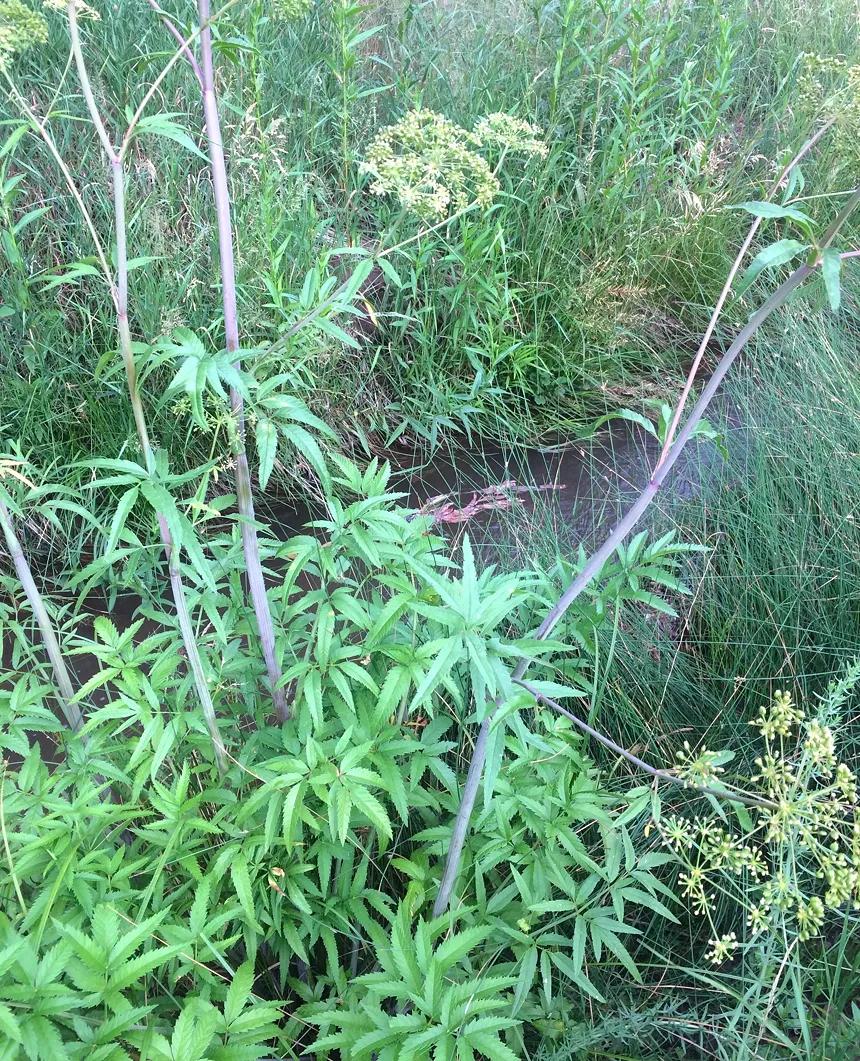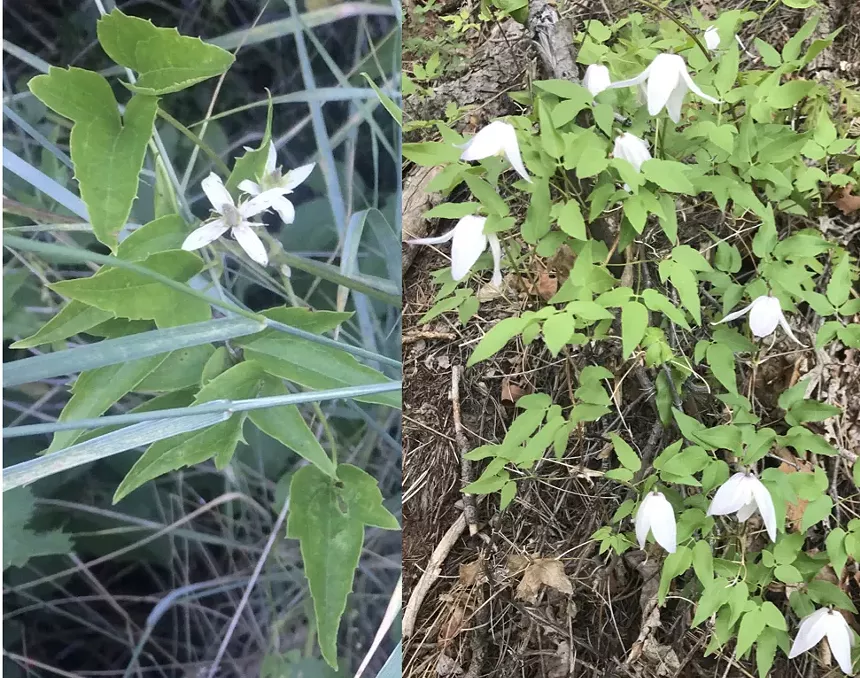Here is a selection of enchanting but seriously toxic plants that grow around the Front Range and beyond:
Mountain Death Camas, Anticlea elegans
Reported as low as the foothills, mountain death camas is more common at higher elevations, up to 12,000 feet, growing in meadows and forest openings and along streams. What the plant lacks in size, it makes up for in appearance — “elegans” refers to the plant’s elegance. In summer, spikes of star-shaped, white-petaled flowers rise above slender, grass-like leaves.
A single species of bee pollinates the plant; other insects don’t fare so well after harvesting the nectar or pollen. As the name implies, mountain death camas is deadly, and the entire plant contains toxins such as zygadenine and zygacine. Meadow death camas and foothill death camas are even more toxic and cause other poisonings. All frequently grow next to lookalike edible plants, such as blue camas, mariposa lilies, and wild onions.
Corn Lily, Veratrum californicum
A high-elevation meadow full of mature corn lilies is a sight to see. Neither a lily nor corn, the mature plants are three to six feet tall, and that’s without the gigantic stalk of green and white flowers that top some of the plants in summer. The leaves are also sizable, and are notable for their large, parallel veins, as well. Corn lily produces a bewildering number of potent toxins, with some — such as veratramine — disrupting heart rhythm and breathing, and others causing grotesque birth defects. For instance, the toxin cyclopamine causes lambs to be born with one large eye when ewes have grazed on the plant.
Though potentially deadly to us, the toxins produced by corn lily (usually) discourage grazing in its habitat, thereby protecting tastier neighboring plants and increasing community diversity. The entire plant is toxic, and young ones might be mistaken for edible or medicinal plants such as wild leek, western skunk cabbage and green gentian. The right panel in the photo shows the latter next to a small corn lily. Can you tell which is which?
Tall Larkspur, Delphinium barbeyi
Larkspur is common where corn lily grows — high-elevation meadows and forest openings — and flowers in July and August. Popular garden varieties bloom in a rainbow of colors, while subalpine larkspur sports gorgeous bluish- to deep violet-purple blossoms on spikes reaching three to six feet tall. “Delphinium,” from the Greek “delphinion,” means dolphin, and refers to the shape of the flower buds. “Larkspur” refers to the mature flowers, which have a spike resembling the sharp hind toe or “spur” of a lark. The attractive leaves are deeply divided into five to seven lobes.
Larkspur provides nectar for bees, hawk moths and hummingbirds, which are important pollinators for many other plants. Other animals, humans included, are sensitive to the plant’s deadly toxins, such as methylcaconitine. All parts of the plant are toxic, and even handling it can cause significant skin irritation.
Western Monkshood, Aconitum columbianum
Beguiling but deadly, western monkshood produces deep blue to violet hood-shaped blooms in July and August. When looking at a stand of larkspur, see if you can spot monkshood plants blooming among them. Monkshood is somewhat shorter on average, ranging from two- to five-feet tall. The deeply divided, lobed leaves of the two plants are strikingly similar.
Pliny the Elder wrote in the first century: “It is established that of all poisons the quickest to act is aconite.” All parts of monkshood (aka aconite) are toxic, containing aconitine and other toxins. Even handling the plant can cause numbness and tingling in the hands. If the skin absorbs enough plant sap, the effects can extend up the arms and ultimately cause heart symptoms. For bumblebees, however, the plant is not a problem — they pollinate it.
The leaves of western monkshood and tall larkspur resemble those of local species of wild geranium. This is potentially a problem if you are trying to dig the root of wild geranium — used medicinally — when it’s growing among monkshood and larkspur, especially if none of the plants are blooming.
Poison Hemlock, Conium maculatum
In 390 BCE, the Greek philosopher Socrates drank poison hemlock juice as punishment for “corrupting the youth” and other infractions. The witness report was likely a sanitized version, as death by hemlock isn’t as peaceful as described, and the mind remains clear to the end. It’s one of the deadliest plants in North America due to the toxin coniine and related chemicals contained in all parts of the plant.
Classified as a noxious weed in Colorado, poison hemlock proliferates along streams, drainage ditches and pasture borders, and also pops up in yards and vacant lots. When young (shown in the photo), poison hemlock resembles parsley or carrot tops. The three plants are related, though the differences become more obvious when hemlock grows several feet tall. Flattish clusters of small, white flowers top hemlock when it blooms from April through July. These mature into clusters of ribbed, brownish fruits. The stalk and stems are green and often have purple spots (“maculatum” means “mottled”). The whole plant smells unpleasant and musty, like a hamster cage that needs cleaning.
Spotted Water Hemlock, Cicuta maculata aka. Cicuta douglasii
Water hemlock, poison hemlock’s more toxic cousin, is another of North America's deadliest native plants. It grows in and along streams, drainage ditches, wet meadows and swampy areas from the foothills to around 8,000 feet. The clusters of small, white flowers topping water hemlock in June and July resemble those of its edible relatives, carrot and parsley. “Maculata” means “spotted” and refers to the purple spots commonly found on the stems. Stems can also be solid green or solid purple. From a distance, the serrated leaflets of water hemlock superficially resemble those of cannabis, though they are obviously different upon closer examination.
All parts of the plant are poisonous due to cicutoxin and related toxins. Despite its notoriety for human poisoning, water hemlock is an important plant for bees and other pollinators.

Silvery lupines are found in high elevation meadows, forest openings and along roads.
Anna Marija Helt
This lovely plant — festooned with purple flowers in summer — ranges from one to three feet tall and is one of the most common lupine species in the southern Rockies. It grows in 10,000-foot-high meadows, in forest openings and along roads. The fertilized flowers develop into fruits that look similar to pea pods. Indeed, lupine and peas are related. The distinctive, silvery green compound leaves have five to ten leaflets that radiate out in a circle.
People eat the seeds of less toxic lupine species after processing them to remove the offending chemicals, but silvery lupine and several other species can have high levels of toxins, such as anagyrine and sparteine. Human poisonings and fatalities from lupines are rare, but they have happened, and children are more susceptible (and more likely to eat the seeds).
Clematis, ligusticifolia and columbiana
Dialing it down on the toxicity scale is Clematis. Clematis plants are creeping or climbing vines, and most types drop their leaves in the fall. Several species of clematis grow on the Front Range, including the two shown. On the left is western white clematis (Clematis ligusticifolia), also known as virgin’s bower. It grows in thickets along streams, on woody hillsides and in conifer forests, producing small white flowers from mid- to late summer. On the right is rock clematis (Clematis columbiana), sporting lantern-shaped white-to-purple flowers from late spring through mid-summer. It grows in open or wooded areas, and even on talus slopes (hence the name “rock” clematis).
All parts of clematis plants can cause severe pain and ulcers in the mouth when chewed, due to production of a chemical called protoanemonin. The toxin can also irritate the skin and nostrils. We’re not talking deadly here, but very acutely unpleasant. If someone (or their dog) were able to eat enough clematis, serious toxicity could ensue, but the bitter taste and irritating properties typically prevent ingestion of more than just a little bit of the plant.
Red Baneberry, Actaea rubra
When it emerges in mid-to-late spring, red baneberry blends into the green of Rocky Mountain forests. But it sure stands out when the spikes of white, frothy flowers bloom and, later in the summer, the bright-red — or sometimes white — berries fruit.
Is it deadly? Most references say yes, especially with respect to the berries. Few, if any, of these references cite primary sources for that information, such as case studies or research papers. If citations are included, they’re usually to another reference that lacks primary source data. In fact, a 2010 research study, an information page on Colorado State University’s website and a North American veterinary guide to poisonous plants state that no clear cases exist of human or animal fatalities from North American red baneberry at the time of their writings. The research study failed to identify any known strongly acting toxins. And one of the researchers, who must have picked the short straw, suffered no ill effects after eating up to twelve berries over a two-hour period. This is consistent with a few old reports, but contrasts with a taste test published in 1903 in which the taster suffered deleterious effects from eating several berries. The conflicting accounts also extend to a European species of baneberry reputed to have killed children there who ate the berries.
What gives? Are there cases of mistaken plant identity? Do berries from plants growing in different regions or conditions have different chemistry such that some are deadly and others are not? With the unknowns, do keep the plant and its berries out of your mouth.
Apparently, the taste isn’t worth it anyway.





















